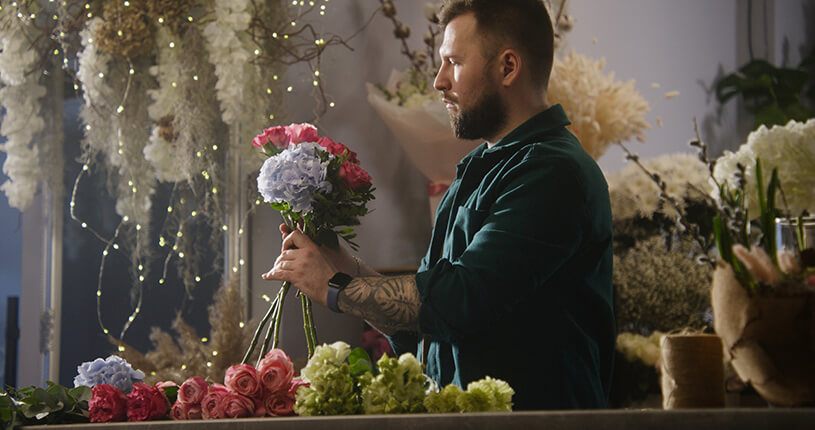If you’re at home in nature and want to use your creativity for flower arranging and design, then setting up as a freelance florist could be a direction worth exploring.
Maybe you’re thinking of floristry alongside other work, or perhaps you’re ready for a complete career change, there’s a few things to consider. Specialist training, marketing, and legal and tax obligations are some of the areas you’ll need to research first.
We have a general guide that covers all the steps to starting a small business, but here we’ll cover specific requirements for floristry, including:
What is a florist?
A florist is a creative person who makes bouquets and flower arrangements for special occasions, events, and funerals.
Hand tied bouquets? Wedding flowers? Office flowers? You could work in all these areas or choose to specialise.
Some florists grow their own flowers while others source from local farms or wholesalers from the UK and overseas. They’ll find blooms that are in season or import tropical flowers from countries around the world.
Floristry and flower arranging
As well as working with cut flowers, florists also work with dried and silk flowers to arrange their pieces.
A flower arranger may work in a florist shop, but their specific role is on creating things for events and displays. For example, flower arches for weddings, or corporate events.
Professionals work with a range of flower arranging supplies, including ribbon, floristry wire, and tape.
How to become a florist – a step-by-step guide
1. Skills you need
Along with a love (and expert knowledge) of flowers, you’ll need to be creative with an eye for detail to design beautiful flower arrangements.
You’ll also need good customer service skills as you’ll be working with people to create their vision, and dealing with suppliers on a daily basis.
2. Florist and flower arranging courses
You don’t need any formal qualifications to become a florist, but there’s a range of courses out there to help you grow your knowledge.
You can study floristry at colleges across the country, from a Level 1 Diploma for beginners right up to Level 5. You’ll also be able to find floral design courses and flower arranging courses if you want to specialise.
City & Guilds offers a Higher Diploma in Professional Floristry if you want to add to your qualifications later.
If you’re looking for a beginners flower arranging course, this is often included in most introductory florist courses.
With a bit of internet research you’ll also find online florist courses – but make sure they’re specifically designed for professionals. There’s lots of workshops for hobbyists out there, such as Christmas wreath making, so take the time to do your research and find the right course for you.

Photo: Framestock/stock.adobe.com
3. Choose to be an online florist or open a shop
Your next big decision will be whether to open an online florist or run your business from a brick-and-mortar shop, or from home.
From home – you could set up your florist business from your kitchen table if you like. Although make sure you know the rules about running a business from home and check the terms of your mortgage or tenancy agreement.
A retail shop – florists can work in a high street store to create arrangements and bouquets for customers and sell cut flowers to locals.
Online – if you decide to set up an online florist then you’ll need to think about your website and how you integrate technology for people to order services and blooms online. Be sure to do your research on your competitors too.
You could also sell your flowers and bouquets on a market stall.
4. Tax and registering as self-employed
Our guide to registering as self-employed goes into more detail, but these are the key points to remember:
- sole traders need to register with HMRC and submit an annual Self Assessment tax return
- limited companies need to register with Companies House, pay corporation tax, file a company tax return, and pay VAT (and as a director you’ll also need to submit a Self Assessment to HMRC)
Business accounting is complex so you might want to get an accountant – and always remember to keep accurate records.
5. Florist insurance
Organising florist insurance is an important item on your to-do list once you’ve set up your business and started selling to customers. If there’s an accident or you make a mistake in your work, having the right cover can protect your business from expensive legal costs or replacing damaged stock.
Simply Business offers tailored insurance for florists and you can build your policy depending on your business. Public liability insurance is the main cover you’ll need, which protects your business if you cause injury or property damage. You also might want to look at stock cover in case your flowers and floristry stock is lost, stolen, or damaged.
Remember if you decide to diversify your business then that can have implications for your insurance. Make sure you let your insurance provider know if you take on new staff, or start offering workshops or even sell a different product so you always have the right level of cover.
6. Join professional networks
The floristry industry has a range of professional bodies you might choose to join. These can be a great way of continuing your professional development, connecting with other florists, and demonstrating to your customers that you know your stuff.
- British Florist Association – a not-for-profit organisation giving you a range of benefits, including membership discounts and a profile in their florist directory to help people find your services
- Institute of Professional Florists (created by the British Florist Association) – an industry body created to maintain standards within the floristry world. There are different membership levels depending on your experience and qualifications and you can display the logo on your marketing materials
- online community groups – find people in your industry or just connect with business owners to share experiences and tips in groups like this Facebook network for women in business
7. Marketing your floristry services
Next you need to think about marketing your florist business. Word of mouth can be powerful, but you’ll also need to make sure people can find you online.
That’s where building a simple business website and setting up a profile on Google comes in. It’s also a good idea to choose a few social media channels that are popular with your potential customers so you can promote your work.
The nice thing about running a florist business is that it lends itself to beautiful imagery. Are you on Pinterest or Instagram? You could use social media to share the images of your creations to show people your skills and attract new customers.
Linking up with other businesses can be another way to grow your customer base. For example, if you specialise in wedding flowers, could you showcase your services alongside a wedding venue or other suppliers to cross-promote your business to engaged couples?
Read more: Expert tips for marketing and advertising your small business.
How much you can earn as a florist
Florists earn between £13,000 and £24,000 a year, according to the UK government’s National Careers Service. However, this is based on someone employed in a florist shop.
As a florist business owner, you’ll have more experience and the ability to set your own prices. The amount you can earn will depend on a range of factors, from business location to the types of services you offer. For example, wedding flowers can command higher prices and a good profit margin compared to one-off bouquets.
You can have a healthy profit margin if you keep an eye on waste and manage your other costs carefully. For example, look into seasonal and locally grown flowers to avoid the complexities (and environmental concerns) of importing your blooms.
How to grow your floristry business
You’ve been working hard growing your florist business – well done. But it’s important to maintain momentum and watch out for competitors taking your share of the market.
Perhaps you now want to focus beyond the flowers and set your sights on a fully-stocked shop. You could offer other gifts and accessories, such as:
- chocolates
- house plants
- gift hampers
You might also want to think about offering workshops and courses for groups and events.
Whatever you choose to do next, make sure you keep your business plan updated so you know where you’re going.
Alternatives to floristry
Not sure if working as a florist is right for you? Check out some of our other guides and small business ideas:
Do you have any unanswered questions about how to become a florist? Post a question below and we’ll do our best to answer.
Insurance for florists
It’s quick and easy to compare quotes for florist insurance. Choose from a range of cover options, including public liability insurance and stock cover. Run a quote today to get started.
Photo: alfa27/stock.adobe.com
